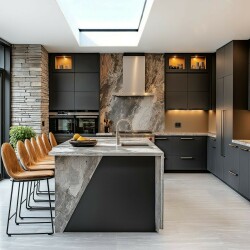Research has consistently shown that while consumers enjoy the benefits of a conservatory, they are actually only using the space for approximately one third of the year and would of course, like to use it more. This has sparked an increase in the number of solid or tiled roofs being retrofitted onto conservatories, something which can often prove expensive and time-consuming for the consumer. Andrew Thomson, Research & Development/Technical Director at Ultraframe takes a look at how the latest development in conservatory roof technology provides a cost effective alternative which allows homeowners to enjoy their conservatory every day of the year.
It’s common knowledge that conservatories can often overheat in summer and become too cold in winter, making them too uncomfortable to sit in. The reason for this is that in summer, most conservatories simply don’t reflect the heat and end up overheating, while in winter, the roof’s low insulation value can become a problem.
The effectiveness of insulation is gauged by it’s U-value. A room which has total insulation, with no heat loss, is measured as having a U-value of zero. The Passivhaus Institute – which provides eco design guidance to Europe’s home builders - sets the target figure of 0.8 for wall glazing.
However, the typical U-value of a conservatory roof is in the range 1.1 to 1.7 and the poorer the level of insulation then the faster the warm air at the ceiling turns as cold as the air outside. The warm air in the room below then rushes up to redress the balance, pulling cold air into the room from the windows. This can be combated by turning up the heating, however even with constant heating, a comfortable temperature will only be achievable in the middle of a room.
Also, by increasing the heating in a property, the homeowner is leaving themselves open to large utility bills. For example, a roof with a U-value of 1.70 requires approximately 2085 kilowatt hours of energy to keep the room heated all year round.
The Magic Number
If a conservatory roof is able to achieve a U-value as low as the Passivhaus target of 0.8, the surface temperature of the glazing is significantly increased and the heat transfer from the air inside the room to outside begins to significantly slow down. This means that warm air within the room is stable, pushing back the cold air at the surfaces and providing a more comfortable temperature throughout the whole room. This effect means that the occupier of the room ‘feels’ more comfortable, even if the thermostat is turned down by as much as 3 degrees centigrade.
Traditionally, homeowners have looked to achieve these lower U-values by retrofitting a solid roof and turning the conservatory into an extension. Switching from a planned conservatory to an extension can often mean doubling the cost and obtaining Building regulation approval which can be timely. Perhaps more importantly, the consumer loses the light and space benefits that come from fitting a glazed conservatory roof. One of the key benefits of a conservatory is that it does not rob light from the adjoining house, unlike a traditional extension with a solid roof.
Next Generation Technology
To provide a more cost effective and thermally efficient alternative to solid roofs, which escapes local authority ‘red tape’ , the leading manufacturer has developed a new style of double layered conservatory roof technology which dramatically improves the roof’s U-value.
Update Cookie Preferences
Until now, conservatory roofs have been designed with a single layer of layer of double-glazing glass or polycarbonate. By adding another layer of polycarbonate, this next generation roof solution can achieve U-values as low as 0.6 and save homeowners hundreds of pounds on their heating and energy bills, as well as increasing winter usage of the area.
Manufactured with heatguard externally and opal polycarbonate internally, sunlight is better reflected, also extending the number of hours homeowners can use their conservatories in the summer months.
The double layer polycarbonate system also provides a barrier to external noise transmission, allowing for a quieter and more peaceful internal environment, making it an ideal alternative to solid roof/tiled extensions.
Leading the Way
As a leading manufacturer of conservatory roofs, Ultraframe is always at the forefront of new conservatory technologies, developing innovative solutions that can be used on traditional conservatories, in addition to new style orangeries or verandas.
Ultraframe’s latest innovation is its Utopia eco roof. Utilising fully thermally broken integrated support extrusions the Utopia roof features two layers of polycarbonate, 35mm Heat Guard Opal externally and 32mm Opal internally, along with an internal chambered ‘T’ cladding and a chambered ridge undercladding.
The first glazed eco-roof of its kind, the centre pane U-value of the two sheets of polycarbonate is 0.6 and yet it is reduced to only 0.53 when the twin wall chambered top cap and undercladding technologies are taken into account, producing a conservatory roof that requires only 788kWh of heating energy a year - 1300kWh less than the average – saving the average household at least £200 on heating their conservatory. Also, by installing a Utopia system as opposed to a solid roof extension, homeowners are able to enjoy the benefits of light and space that come with a conservatory installation.
As the market leader in the design and manufacture of conservatory roofing systems for more than 20 years, Ultraframe’s ongoing commitment to research and development has led to the introduction of this revolutionary new technology which has been designed to provide a bright and modern day alternative to solid or tiled roof extensions.
For more information on Utopia, or any of the Ultraframe offering, visit http://www.ultraframe-conservatories.co.uk/trade/
Alternatively visit




